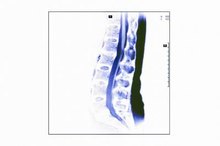Irritable Bowel Syndrome (IBS)–a chronic condition affecting the colon–and urinary tract infections (UTIs)–acute or chronic bacterial infections of the urethra or bladder–can both cause discomfort and lifestyle impairment. A study in the August 2006 issue of “Alimentary Pharmacology and Therapeutics” suggests that they may be likely to occur together, reporting that persons with IBS are more likely to report UTIs. It is important to recognize the symptoms of IBS and UTIs so that you can obtain proper medical care and learn how to manage these conditions.
If you are experiencing serious medical symptoms, seek emergency treatment immediately.
General IBS Symptoms
IBS is characterized by irregularity in bowel function (either diarrhea, constipation, or alternating diarrhea and constipation), abdominal pain and bloating 2. Additionally, you must demonstrate two of these three symptoms: a feeling of relief upon having a bowel movement, a change in the frequency of bowel movements from the onset of the problem and a change in the form or appearance of the stool.
IBS is associated with affective disorders, such as depression and anxiety, and symptoms of IBS are also known to worsen premenstrually. IBS may also flare up in response to stressful events (traveling, certain foods, emotional trauma) and then diminish or disappear for some time, often without clear explanation. Although there is no cure for IBS, lifestyle and dietary modifications or prescription medications may offer symptom relief.
- IBS is characterized by irregularity in bowel function (either diarrhea, constipation, or alternating diarrhea and constipation), abdominal pain and bloating 2.
IBS with Diarrhea (IBS-D) and IBS with Constipation (IBS-C) Symptoms
Frequent Urination & Leg Pain
Learn More
Although some people may alternate between having constipation and diarrhea, most people with IBS tend to have either symptoms of chronic diarrhea or chronic constipation and are diagnosed accordingly with either IBS with diarrhea (IBS-D) or IBS with constipation (IBS-C) 2.
Abdominal pain is the characteristic symptom associated with IBS-D. Those suffering from IBS-D may also experience gas, sudden urges to have a bowel movement and loose stools. Some people with IBS-D have feelings of nausea, frequent urges to have a bowel movement or bothersome feelings that they are unable to completely empty their bowels. Some people may lose control of their bowels and soil themselves when the urge comes on very strongly and suddenly.
Like those with IBS-D, the key symptom among those with IBS-C is abdominal pain and discomfort.
- Although some people may alternate between having constipation and diarrhea, most people with IBS tend to have either symptoms of chronic diarrhea or chronic constipation and are diagnosed accordingly with either IBS with diarrhea (IBS-D) or IBS with constipation (IBS-C) 2.
- Some people with IBS-D have feelings of nausea, frequent urges to have a bowel movement or bothersome feelings that they are unable to completely empty their bowels.
UTI Symptoms
Symptoms of UTIs typically include:
- pain or burning in the bladder or urethra during urination
- a strong urge to urinate--accompanied by the ability to pass only very small amounts of urine
- a feeling of pressure or fullness in the pubic area
- cloudy or bloody (hematuria) urine
- strong-smelling urine
- bacteria in the urine
It is possible for some individuals to have a UTI and experience no symptoms at all. The presence of a fever usually indicates that the infection has progressed to the kidneys. A urinalysis is used to test for the presence of blood and bacteria in the urine to confirm a diagnosis. Antibiotics and analgesics (pain killers) are typically prescribed to cure the infection and relieve discomfort.
- Symptoms of UTIs typically include: * pain or burning in the bladder or urethra during urination
* a strong urge to urinate--accompanied by the ability to pass only very small amounts of urine
* a feeling of pressure or fullness in the pubic area
* cloudy or bloody (hematuria) urine
* strong-smelling urine
* bacteria in the urine It is possible for some individuals to have a UTI and experience no symptoms at all. - A urinalysis is used to test for the presence of blood and bacteria in the urine to confirm a diagnosis.
Related Articles
References
- Alimentary Pharmacology and Therapeutics; Physical and Psychological Co-morbidity in Irritable Bowel Syndrome: a Matched Cohort Study Using the General Practice Research Database; R. Jones et al.; August 2006
- About IBS: IBS with Diarrhea
- Saha, L. Irritable Bowel Syndrome: Pathogenesis, Diagnosis, Treatment, and Evidence-Based Medicine. World Journal of Gastroenterology 2014 20:6759–6773.
Writer Bio
Based in New York City, Tricia Mangan began her writing career in 2001. She has co-authored a National Cancer Institute report and a number of research articles that have appeared in medical journals. Tricia holds a Master of Arts in clinical psychology from Stony Brook University and boasts diverse clinical, research and teaching experience.









